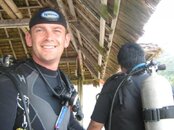When I'm in the water my mask is on my face. If I'm out of the water it is either on, in my hand, clipped off, or carefully stored.
Several reasons for the mask being ON in the water.
1. Safest place for it. Especially if in rough water or surf. (I'm primarily a California shore diver)
2. Can see if I need to put my face in the water - actually in my case I can see clearly period (strong Rx)
3. Keeps water out of my nose. Also I keep my snorkel in my mouth unless I'm on my back - then contrary to training, my snorkel is out of my mouth - Breathing Water Really Ain't Fun.
4. I won't forget to put it on when descending. Don't laugh, I've seen a lot of people try.
Out of the water my mask is usually still on. I'm pretty nearsighted (20/400 with astigmatism) without glasses. Please don't confuse this with blind - I'm still fully functional even without lenses. If off my face I'm VERY possessive of my mask. You should have seen me as the rescue class 'victim'. When my mask was removed the 'victim' came alive long enough to get a 'death grip' on it then lapsed back into 'unconsciousness'.
A lot of my feelings relate to the rough water environment. I've seen a lot of lost masks when they were on a forehead. Not sure if they are safer turned around. But if you are in pool like conditions who cares?
Several reasons for the mask being ON in the water.
1. Safest place for it. Especially if in rough water or surf. (I'm primarily a California shore diver)
2. Can see if I need to put my face in the water - actually in my case I can see clearly period (strong Rx)
3. Keeps water out of my nose. Also I keep my snorkel in my mouth unless I'm on my back - then contrary to training, my snorkel is out of my mouth - Breathing Water Really Ain't Fun.
4. I won't forget to put it on when descending. Don't laugh, I've seen a lot of people try.
Out of the water my mask is usually still on. I'm pretty nearsighted (20/400 with astigmatism) without glasses. Please don't confuse this with blind - I'm still fully functional even without lenses. If off my face I'm VERY possessive of my mask. You should have seen me as the rescue class 'victim'. When my mask was removed the 'victim' came alive long enough to get a 'death grip' on it then lapsed back into 'unconsciousness'.
A lot of my feelings relate to the rough water environment. I've seen a lot of lost masks when they were on a forehead. Not sure if they are safer turned around. But if you are in pool like conditions who cares?




 . That big blue sleeve on your bungeed octo though is going to kill you
. That big blue sleeve on your bungeed octo though is going to kill you 
 .
.